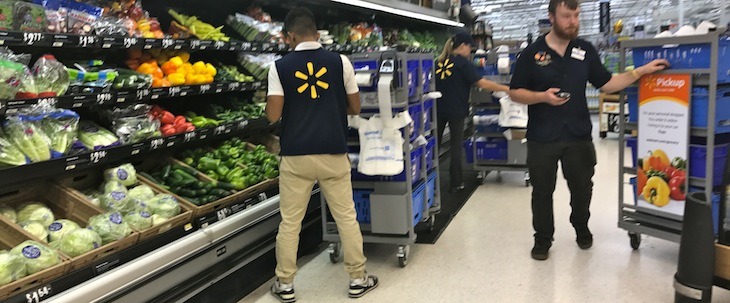U.S. online grocery sales hit $9.3 billion in January
by February 24, 2021 3:26 pm 767 views

Walmart U.S. employees work to fill orders placed online for store pickup.
U.S. online grocery sales for January 2021 hit $9.3 billion, up 15% from November, as more than 69.7 million U.S. households placed on average 2.8 orders across delivery, pickup and ship-to-home, according to the Bricks Meets Clicks/Mercatus Grocery survey fielded Jan. 28-31.
In March 2020, as the pandemic began to spread, U.S. online grocery sales totaled $6.5 billion, with $4 billion of that being delivery to home or curbside pickup, Mercatus reports. By June, online grocery rose to $8.8 billion with $7.2 billion being delivered by first- or third-party providers or picked up at stores. As COVID-19 cases began to decline in late summer, online grocery sales receded back to $8.2 billion by August, falling to $8.1 billion in November. But as consumers again worried about rising COVID-19 cases in January, consumers once again turned to online grocery options.
The January report found $7.1 billion sales, accounting for 77% of total online grocery sales were slated for home delivery by first or third-party providers or for customer pickup. For January, the delivery and pickup segments captured $7.1 billion sales accounting for 77% of total online sales in a market where the customer and sales mix continue to shift toward delivery and pickup services.
Total sales grew 15% in January compared to the November slump and Mercatus said this was driven largely by a 16% increase in the number of households buying online. Among the total household monthly active users, 78% engaged with either a delivery or pickup service, up from 64% in November. Also, 46% used ship-to-home services, which was down from 56% in November. Mercatus said even though January saw a higher overall growth in sales, the number of users fell short of the record 76.7 million consumers who shopped online in April 2020, when much of the U.S. was living under stay-at-home orders.
The average number of total online grocery orders placed by monthly active users for January was flat at 2.8, compared to November. But the order mix changed as the delivery and pickup segments collectively gained nearly six percentage points of order share, and accounted for 66% of all online grocery orders in January. Mercatus also found the order size decreased in January roughly 11% from November as consumers spent less on food stock ups and purchased smaller pack sizes to conserve budgets.
Walmart CEO Doug McMillon said recently this was seen by the retail giant as consumer behavior moved from stock-up to buying only what was needed. He said basket sizes fell in January, reversing a trend from earlier in the pandemic.
Mercatus also asked respondents about their intent to make repeat purchases in the next month. The number of consumers who expressed dissatisfaction fell to 56% in January, down more than 32 percentage points from record high ratings in November. The pickup segment had the greatest decline (35 points) during the period.
The January research revealed that the share of first-time customers climbed by 3 percentage points overall and more than 6 points for pickup in January 2021 compared to November. This first-time customer group has consistently reported lower intent rates in past surveys.
“Even though many grocers remain capacity constrained – especially with pickup – others are growing market share as they staff up or expand pickup to a larger store base,” said David Bishop, partner with Bricks Meets Clicks. “While throwing more labor at the issue isn’t ideal, this, along with improving assembling productivities via enhanced pick and pack practices, is vital to remaining competitive in the near-term and not giving shoppers a reason to go elsewhere.”
McMillon has said Walmart knows shoppers become frustrated by out-of-stocks and limited pickup or delivery time slots which is why the retail giant focused on improving these metrics.
“It’s clear from the data that retailers will face a challenge in holding on to a lot of online shoppers as experience is not meeting expectations,” said Sylvain Perrier, CEO at Mercatus. “To remain competitive with mass merchandisers, regional grocers need to enhance the digital shopping experience so as not to give their customers a reason to spend their money elsewhere.”
He said grocers must look where they can improve operationally and scale efficiently to meet online demand while also deciding which services will be the most effective at revenue protection going forward.
